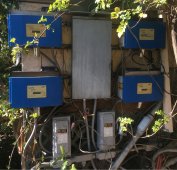simnonharper1971
New Member
- Joined
- Apr 2, 2022
- Messages
- 5
I have 7 panels on an outbuilding roof that i installed a year or so ago. The panels are wired in series and run into a sunnboy 2500 inverter .The system is grid-tied
I have a number of panels (at least 10) left over and would like to use some more .
There is no room left on the roof but i am planning to mount a few more panels on the walls of the outbuilding .
These new locations will be partly shaded during the day, unlike the roof which gets full sun but these panels are left over and id like to put them to use. Because of the partial day shading I dont want to wire them in series with the 7 roof panels as i dont want to reduce the output of the roof when the new panels are in shade which is why i would like to add them in paralle
Does anyone have any experience of connecting up one or two panels in parallel to an existing series installation? Any reason why i can or cannot add panels which would effectively be outputting 35volts to a series string that is outputting over 200volts?
I have a number of panels (at least 10) left over and would like to use some more .
There is no room left on the roof but i am planning to mount a few more panels on the walls of the outbuilding .
These new locations will be partly shaded during the day, unlike the roof which gets full sun but these panels are left over and id like to put them to use. Because of the partial day shading I dont want to wire them in series with the 7 roof panels as i dont want to reduce the output of the roof when the new panels are in shade which is why i would like to add them in paralle
Does anyone have any experience of connecting up one or two panels in parallel to an existing series installation? Any reason why i can or cannot add panels which would effectively be outputting 35volts to a series string that is outputting over 200volts?





